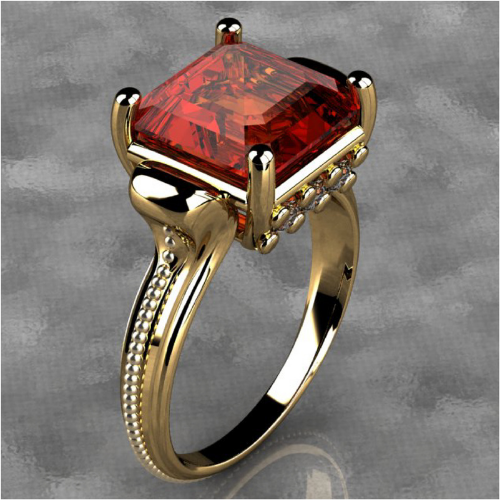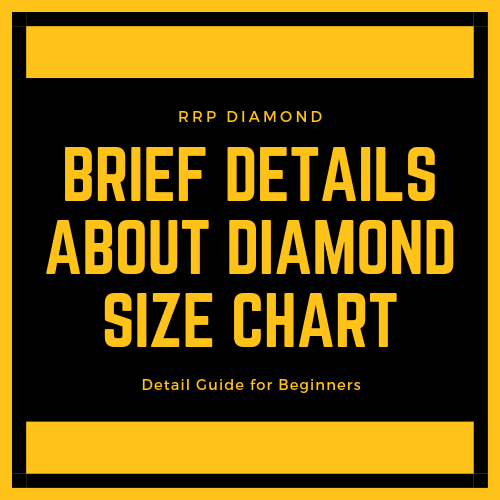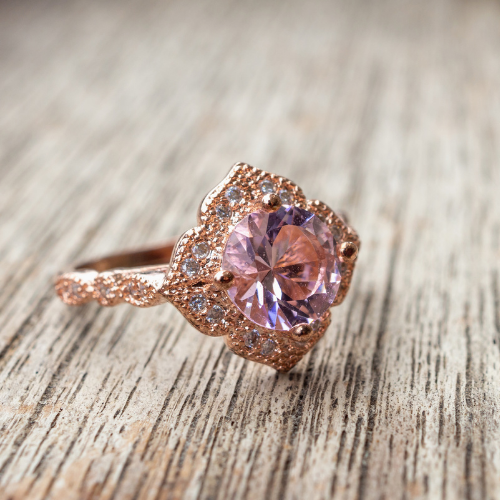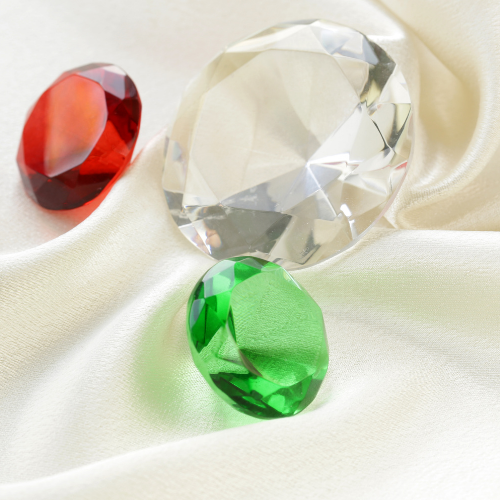
It is often said that the best diamonds are those that are purely colorless. It is also said that the more colorless the diamond, the more pleasing, beautiful, and eye-catching it would be. In fact, the colorlessness of the diamond is what makes the white diamond quite a popular choice for gemstone jewelry.
But that is not the truth. Color is one of the main factors of accessing the quality of a diamond as it is part of 4C along with Carat, Clarity, and Cut. In terms of color, diamonds are graded from D to Z.
D grade diamonds are the absolute colorless diamonds, which makes them rare and expensive. E and F diamonds are quite colorless. G diamonds are near colorless with a slight tinge of yellow in them. Z diamonds have a yellow tinge that is noticeable to the naked eyes.
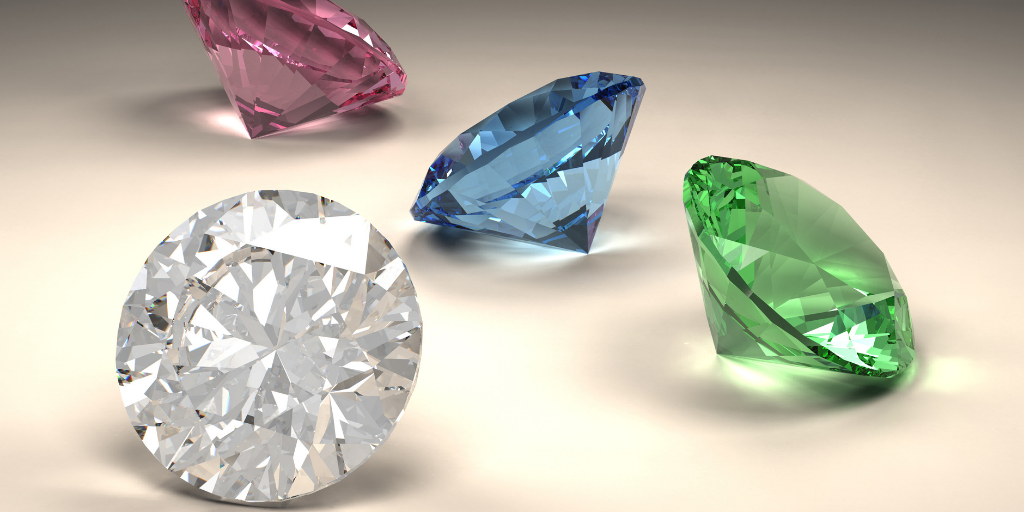
In that range, G color lies at the nearly colorless side of the spectrum. It gets its yellow tinge due to nitrogen atoms that get trapped inside the diamond when it is forming. These particles absorb the color blue and hence result in a yellow tinge of the G-grade diamonds.
G diamonds are a lovely and classy blend of beauty, value, and quality. Since they are of a lower grade, they are not as expensive as D-grade diamonds. They are popular choices for diamonds that are to be placed as small accent diamonds in exquisite jewelry. Since these diamonds are viewed from the top, the color becomes even less visible.
As a matter of fact, G color diamonds look as colorless as D color diamonds until and unless the two colored diamonds are placed next to each other, side by side. With great cut quality, the diamond will sparkle more which tends to hide color in an even more effective way. Since they are gorgeous and have a lower price tag, G color diamond is often preferred for engagement rings as center stones.
What makes a G-grade diamond an effective choice?
When it comes to colorless diamonds, G color is quite a popular choice. Nearly colorless, G color diamond showcases a slight warm tinge of yellow.
The difference between the two cannot be spotted in any jewelry in normal regular daylight, as long as it is not placed next to a diamond of D or E grade. Even then, the tinge is so minute that the difference between the G grade diamond and a D grade diamond cannot be told by naked eyes; only professionals can tell that difference and that too in controlled lighting in laboratory conditions.
With a right cut, a G diamond can appear to be a D diamond. The best cut for G color diamond is a round brilliant cut. The cut makes maximum use of the reflective and refractive properties of the diamond and with maximum brilliance and sparkle, the color is highly subdued, making it less visible. In reality, if a diamond of G color is cut in a fine and high-graded way, it can look much better than higher quality diamonds.
As long as diamonds with high carat value are not chosen, you’d end up with a gorgeous diamond with a G grade. The more is the carat value, the bigger the diamond would be, and hence the more color it will show.
G-grade diamonds are also cost-effective. They are cheaper than diamonds of higher grade with similar clarity, cut, and carat, by about 10%-25%. You could end up having a diamond that bears a resemblance to the nearly white or colorless diamond with a lower price tag.
When does G grade diamond become a suitable choice?
G color diamond works great in a multitude of settings. Be it a center stone or side accent stones, G-grade diamonds look as bright and sparkly as a pure colorless diamond of D grade.
G grade diamonds are usually preferred as accent stones as they tend to compliment the center stone in much better lighting. Halo setting to a 3 stone setting with these diamonds is quite commonly seen. Not only does this kind of setting makes the central diamond appear brighter, but it also complements the accent stones and makes them appear as colorless as possible without a hint of yellow.
If you are running on a little tight budget and are looking for a diamond that has the colorless appearance of diamonds of D, E, F grade but without the price tag of the same, then G grade diamonds are a suitable choice for your jewelry.
If round brilliant cuts are what you fancy, then going lower on the scale will not hurt the appearance, brilliance, scintillation, or fire of the diamond and overall piece of jewelry. G grade diamond in round brilliant cut appears as colorless as D grade or E grade diamond.
If you are someone who has a preference for warmer toned diamonds compared to the ice-cold vibe of colorless diamonds of D, E, F grade, then go for G grade diamonds. You can enhance these warmer tones by opting for the G color diamond in emerald cut or Asscher cut. These cuts have a large table with step cuts. Not only does that make the color visible but also makes it seem uniform.
Also Read: Difference Between Real Black and Treated Black Diamond
What diamond-cut compliment G-grade diamonds?
G grade diamonds are available in all the cuts, though some of them are not quite favored.
Compared to the more traditional cuts, fancy cuts have an upper hand in terms of popularity and price; though nothing can beat the fame of a round brilliant cut diamond. Fancy cuts such as the oval, cushion, marquise, radiant, emerald, Asscher, pear, princess, cushion, and heart tend to in and out of fashion and hence cost less. Some of them also have a modern touch which pleases a lot of modern women in terms of jewelry.
The round brilliant cut is the most famous diamond cut, no matter what color grade. It is the most brilliant and produces great and captivating dazzle, glitter, scintillation, and fire. This cut makes maximum use of the diamond’s reflective and refractive properties. This much glam in the diamond heavily overpowers the small amount of color the diamond has, making it appear as if it is as colorless as D grade diamond.
Pear, oval, and marquise cuts tend to show the color at the tips where it gets concentrated. On top of that, it is hard to find a pear cut with the ideal teardrop shape. Thin and elongated pear cut diamonds show more color than stoutly pear cut diamonds. Marquise diamonds are comparatively less popular and hence cheaper. Also, their cuts make them sparkle, which again covers up the yellow tinge of the G color diamond.
Other cuts such as Princess, Emerald, Asscher, and Radiant cuts have sharp and linear edges that tend to show visible color.
Princess cuts with smaller carat value will not have this as a problem, compared to the princess cuts that have a higher carat value.
Cushion cuts have soft, curved corners rather than pointy ones and they have a thick and bulky appearance. As they are a take on the old miner cut, a traditional cut, and are a modification on round brilliant cuts, their warmth is overshadowed by their brilliance. This makes a diamond of G color perfect for it.
Radiant cuts have trimmed corners. While it does have the advantage as the tinge of the diamond will not get concentrated, it still has a large table and modified step cuts. This makes the color still visible in the diamond, but only if one tries too hard and compares it with a diamond of D or E grade.
Emerald and Asscher cuts feature step cuts. This makes them not as brilliant as others on the list. As they are not brilliant, their G-graded warmth is not hidden properly and can be quite visible. Since the pavilions of these diamond cuts focus on the contrasting flashes of white and black, the yellow might be visible to the naked eye. But if organized in a setting with proper positioning and placement then the warm yellow tinges of these two cuts can be hidden.
Heart cut diamonds are rare. They are hard to cut. And due to these, these diamonds are not popular and uncommon. It is hard to find a heart diamond that looks like a proper heart with proper symmetries, lines, and curves and not too fat, long, or misshapen. The two curved lobes on top and the pointy tip of the end need to be clearly defined.
When it comes to a heart diamond, G color is actually suitable if the heart shape is proper. The color might get concentrated at the bottom pointy tip but with suitable fitting, it can be hidden.
The best metal setting for G graded diamond
G graded diamonds look great with every metal out there. Diamonds are highly reflective so whatever metal you will choose will be reflected by the diamond as well.
White metals like platinum or white gold compliment the G color diamond. The metal can even affect the color of the diamond and make it seem a bit higher on the scale than it actually is.
Rose gold and yellow gold have warmer tones in them. Both the metals create less contrast between the warmth in them and the warm tinge of the diamond and help bled the yellow hue.
This makes the diamond appear whiter and more colorless. But in some cases, this enhances the hue of the G grade diamond, making it appear yellower.
In such a case, it is best to go for a setting where the jewelry is made out of colored metal like rose gold or yellow gold, and the prongs that are supposed to hold onto the diamond are white gold or platinum. This type of setting makes the center diamond of G color appear whiter with a colored metal body.
But if you want the warm yellow tinge of the G color diamond to be visible, opting for a piece of jewelry with a colored metal body and prongs of the same color can help you achieve that look.
This type of setting looks most well placed with jewelry that have a vintage style and design. This vintage and antique vibe can be further enhanced by opting for rose gold rather than yellow gold.
The opinion on the ‘perfect’ metal for a G-grade diamond is highly subjective. Irrespective of other people’s opinions, it all boils down to what pleases you and appeals to your eyes and interests, while also fitting well within your set budget.
Also Read: Difference between Full Cut and Single Cut Diamonds – Which one to choose?
Conclusion Thoughts
It is practically impossible to tell the difference between a G-graded diamond and a diamond of D, E, F grade with just the naked eye in everyday lighting. They all appear similar and colorless. G graded diamond is cost-efficient and will give you the look of a D-grade diamond without having to pay the hefty price tag.
G graded diamonds look great as centerpieces as much as side stones, accent stones, and pave stones. When set in a proper metallic setting, and based on what you like, they can give a colorless appearance or warm-toned appearance.
Round brilliant cuts do the best job at hiding the warm tones of the G diamonds. Their sparkle, brilliance, dazzle, and glitter overshadow the tiny amount of color and make it appear almost entirely white and colorless.
Other cuts that look good with G-graded diamonds are marquise, pear, oval, and heart cuts; as long as the shape is symmetrical without any error and the shapes are visible.
Radiant, Emerald, and Asscher cuts show the color better than other cuts, especially the latter two. Their lack of sparkly brilliance enhances the yellow tinge.
All in all, a G-graded diamond is a sensible purchase. Beauty is in the eye of the beholder. G grade diamonds might lie a little low on the spectrum of the colorless diamond but they can be just as splendid as the perfectly colorless diamonds.
